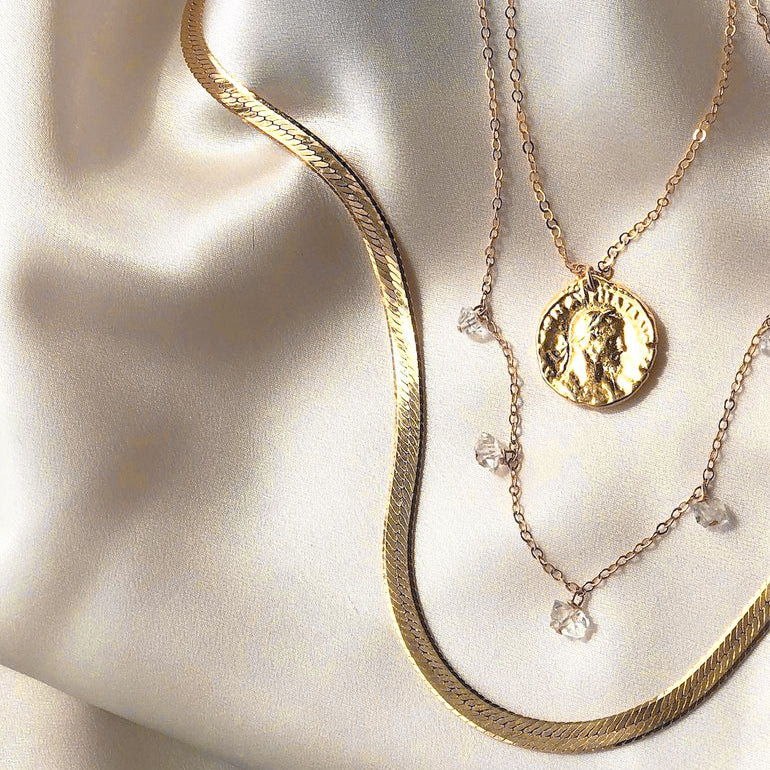What is The Meaning of Roman Coin Jewelry?

Not many people know that ancient Greeks issued the first coins in the world in the 6th century BC. The most beautiful thing about it is that the symbolism is preserved in many artistic ways, one of them being coin jewelry. No matter if you are a history geek or coin collector, you can find ancient coin jewelry to be a perfect blend of symbolism, history, and beauty.
If there’s one thing that can be said with certainty, it’s that coin jewelry is one of the most timeless accessory trends of all time. It has been worn all throughout history, and while it changed its form, it has never changed its symbolism.
We’ve witnessed yet again the remarkable comeback of coin jewelry. Nowadays, while coin necklaces such as Old Coin Necklace scatter the high street and cement their place in layering combinations, the truth is that not many people know about their special meanings and symbolism.
Some of the main reasons why coin jewelry is so popular today are:
- Sentimental value
- Due to their variety
- Due to their simplicity and beauty
The current jewelry trend is heading towards ancient times, with Greek coin necklaces and Roman coin necklaces, such as Roman Horseman and Sword Coin Pendant, increasing in popularity as women look for more history and meaning in their jewels than just looks.
As they date back to ancient cultures and countries like Rome, Egypt, and Greece, tons of popular coins in jewelry are actually Egyptian, Roman, and Greek. They are considered the most traditional. They portray many royal as well as spiritual figures and have intricate carvings.
Meanings Behind Coin Necklaces
Generally, there are many meanings behind coin necklaces and jewelry, and it all depends on the type of coin the wearer wears. Historically, coins were considered love tokens, given to loved ones, and engraved with sentimental messages.
At one point in time, coin jewelry was also referred to as sweetheart jewelry because soldiers sent them home to their children and wives. On the other hand, coion necklaces were also worn and/or given for travel, good fortune, and luck.
As stated previously, coin necklaces can also depend on the type of coin one choose. For instance, Ancient Greek coin jewelry often features goddesses and gods who represent emotions and powerful feelings.
Another example is cross pendants. Wearing a pendant that features a cross is typically a symbol of faith; hence it represents that person’s beliefs, promotes awareness, and provides comfort. An example of this type of necklace is Theodosius Christian Cross Pendant.
History of Roman Coin Jewelry
As you already know, in ancient times, jewelry represented power, wealth, status, and influence on one hand and spiritual purposes on the other. Women in ancient times wore jewels such as rings, fibula, earrings, and of course, necklaces.
Back then, it was totally normal for women to wear multiple pieces of jewelry at once as well as to stack rings or bracelets as desired—the more, the merrier. As for the men, men wore fewer pieces of jewelry. They liked to layer rings where each ring represented something important in the person’s life.
So when you compare the ancient times of wearing jewels with today, nothing much has changed, honestly. One thing that is significantly different is that men don’t wear jewelry not nearly as before. In fact, in today’s society, men who wear jewelry are portrayed as weak and not manly enough.
For that, all we have to say is that we need to put an end to toxic masculinity in fashion. Both men and women should equally have the right to wear whatever jewels they want without being labeled as not feminine or not masculine enough. The only time you shouldn’t wear jewels is when you exercise.
Most Common Materials Used for Roman Coin Jewelry
Two primary metals used during these ancient times were silver and gold. However, that was popular only among the wealthy and upper classes. The truth is that the average person only wore jewelry made of cheap metals such as copper and bronze.
At that time, the Romans perfected mass production, which led to more affordable jewelry types being mass-produced, making jewelry available to the masses and not just for the rich ones.
Additionally, Romans used a lot of gemstones. Gemstones such as ruby, pearl, and amethyst were extremely valued, but even semi-precious stones like amber and topaz were popularly used.
At the end of the day, there’s no doubt that Romans were people of wealth and power who liked to demonstrate their riches through their jewelry as well as lifestyle. However, as you know, such an exuberant era did not last forever, as greed and corruption swept under the rug and slowly ate away the foundation of their society.
SHARE:


